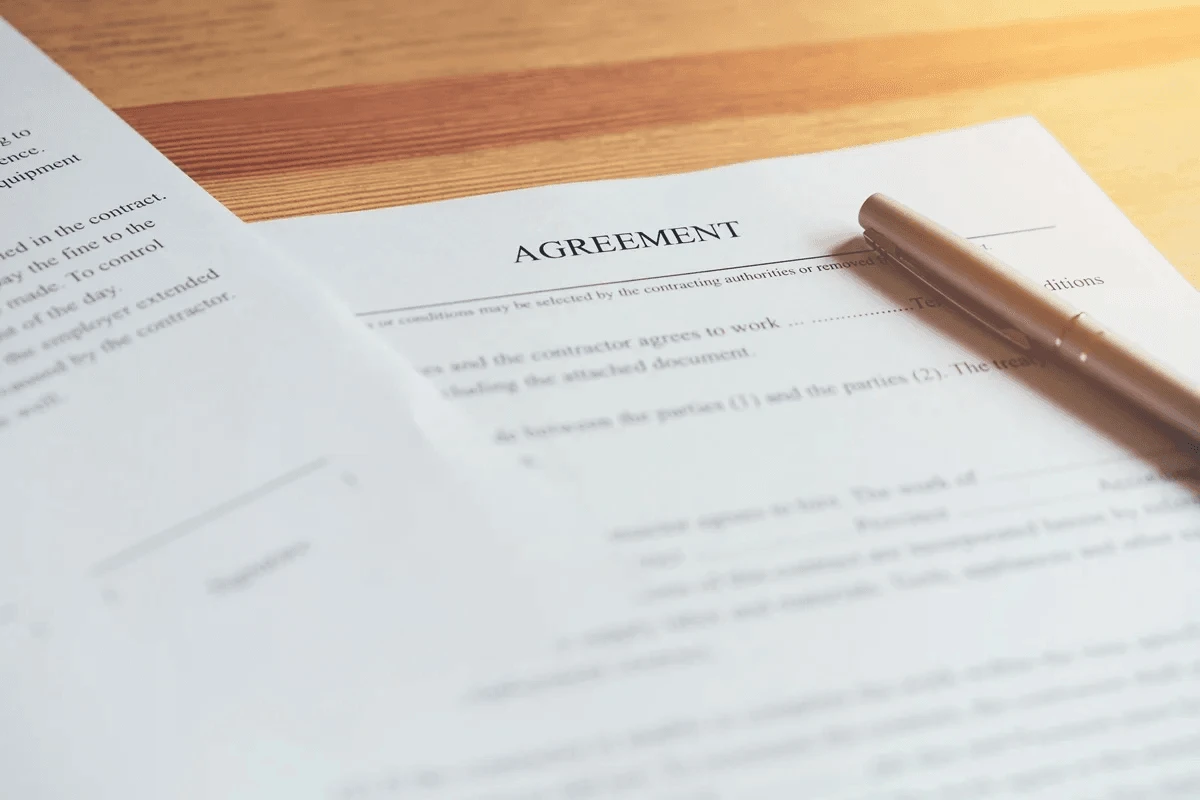A Non-Disclosure Agreement (NDA) is a fundamental legal tool that protects sensitive business information—such as business plans and customer lists—from being disclosed to unauthorized parties. Whether you’re negotiating a partnership, hiring contractors, or discussing investment opportunities with potential investors, NDAs help safeguard your competitive edge and maintain your competitive advantage by protecting proprietary information.
This article provides a comprehensive overview of what NDAs are, how they operate, and how to utilize them effectively. We’ll cover legal essentials, use cases, best practices, and frequently asked questions—all in a clear, accessible format tailored for business leaders and legal teams. NDA templates are also available to streamline the NDA creation process and ensure legal reliability.

What is a Non-Disclosure Agreement (NDA)?
A Non-Disclosure Agreement (NDA) is a legally binding contract and legal contract that establishes a confidential relationship between parties. The primary purpose is to prevent either party from sharing proprietary or sensitive information with outsiders. The NDA creates a legal framework in which the parties agree to maintain confidentiality.
Key Characteristics of an NDA:
- Confidential Information Defined: Emphasizes the importance of defining confidential information by clearly specifying what types of sensitive data are protected and identifying the information disclosed that must remain confidential.
- Obligation of Confidentiality: Outlines the receiving party’s obligations regarding the handling of the information.
- Term Duration: Specifies the duration for which confidentiality must be maintained.
- Exclusions: Identifies what information is not subject to confidentiality.
- Consequences of Breach: Details remedies or penalties for violating the agreement, including the possibility of legal action and financial damages.
Types of NDAs
Whether you’re protecting a product concept, a strategic partnership, or sensitive internal data, choosing the right type of NDA is essential to safeguarding confidentiality. Below are the most common types of NDAs and when each is typically used.
Unilateral NDA
Used when only one party shares confidential information, such as when a startup pitches to investors. Unilateral NDAs are also commonly included in an employment contract signed by new employees to protect sensitive company information during the onboarding process. In a unilateral NDA, the disclosing party is the one sharing confidential information, and the agreement outlines the responsibilities and protections for that party.
Mutual NDA
Employed when both parties exchange confidential data—also known as a bilateral NDA—it is commonly used when two companies enter a joint venture or merger.
Multilateral NDA
Involves three or more parties, typically used in complex business collaborations.
When to Use a Non-Disclosure Agreement
NDAs, sometimes referred to as a ‘proprietary information agreement’ or ‘confidentiality agreement,’ are essential tools for protecting sensitive business data.
Businesses should consider using an NDA in the following scenarios:
- Before entering joint ventures or partnerships
- When pitching new products or ideas
- During hiring processes involving access to trade secrets
- In mergers and acquisitions
- With independent contractors or freelancers
- When parties need to disclose information under a proprietary information agreement or proprietary information agreements
Requirements for a Valid NDA
For a Non-Disclosure Agreement (NDA) to be legally enforceable and truly protect confidential and proprietary information, it must meet several essential requirements. First, the NDA must be a written agreement clearly outlining the confidential relationship between two or more parties. Each party involved in the disclosure agreement should be specifically identified, ensuring there is no ambiguity about who is bound by the terms.
A valid non-disclosure agreement NDA must also provide a detailed definition of what constitutes confidential and proprietary information. This ensures that all parties understand exactly what information is protected and what falls outside the scope of the agreement. The NDA should clearly state the obligations of the receiving party regarding the handling, use, and further disclosure of such information.
Additionally, the agreement must specify the duration of confidentiality, any exclusions (such as information already in the public domain), and the remedies available in the event of a breach. Proper execution is crucial—each party must sign and date the NDA, demonstrating mutual consent and understanding of the terms.
By including these key elements, a non-disclosure agreement not only protects confidential information but also provides a strong legal foundation for any business relationship involving sensitive disclosures.
Legal Considerations and Enforceability
NDAs are generally enforceable, but courts scrutinize them closely. Well-drafted NDAs offer legal protection for sensitive information by clearly outlining obligations and remedies in the event of a breach. Here are key factors influencing enforceability:
- Reasonableness: Duration and scope must be fair and not overly restrictive.
- Jurisdiction: Legal standards vary by state and country.
- Clear Language: Ambiguity can render an NDA void.
- Proper Execution: Must be signed by all involved parties.
- Consequences of Breach: Violating an NDA can result in potential lawsuits, financial penalties, and reputational harm.
Example Clause: Confidential Information
“Confidential Information includes but is not limited to business strategies, customer data, financial reports, proprietary software, product roadmaps, confidential material, customer lists, business plans, financial information, and private information.”
How to Draft an Effective NDA
An effective NDA should be:
- Clear and Concise: Use straightforward language to convey your message effectively. Consider using NDA templates to streamline the drafting process and ensure all essential elements are included.
- Tailored to Purpose: Customize for specific business scenarios, as NDA terms may vary depending on the business context, such as the type of information shared or the parties involved.
- Timeframe of Agreement: Clearly specify the time period for which confidentiality obligations will apply.
- Legally Reviewed: Consult legal counsel for jurisdiction-specific advice.
Essential Clauses:
- Definition of Confidential Information: Clearly outlines what information is confidential and protected, including trade secrets, business plans, customer information, financial data, proprietary technology, and intellectual property. Precise definitions prevent ambiguity and ensure both parties understand the scope.
- Exclusions from Confidentiality: Specifies information not subject to confidentiality, such as public domain data, independently developed information, or data legally obtained from third parties, clarifying what can be freely used.
- Obligations of the Receiving Party: Requires the recipient to keep information confidential, restrict access to authorized individuals, use it only as agreed, and promptly report any unauthorized disclosures.
- Timeframe of Agreement: Defines the duration of confidentiality obligations, which may range from a set period (e.g., 2-5 years) to indefinite for trade secrets.
- Return or Destruction of Information: Upon termination or request, the recipient must return or destroy all confidential materials to prevent prolonged possession.
- Remedies for Breach: Outline the consequences of violation, including injunctions, monetary damages, and legal fees, to provide deterrence and legal recourse.
Understanding these elements is essential for drafting an NDA that effectively protects sensitive information and supports a trustworthy business relationship.
Common Mistakes to Avoid
While NDAs are powerful legal tools, they can easily lose their effectiveness if poorly drafted or misused. Many organizations make avoidable errors that weaken the agreement’s enforceability or create legal loopholes. To ensure your NDA offers real protection, watch out for these common mistakes:
- Overly Broad Scope: Trying to protect non-confidential or public information—NDAs cannot cover public knowledge.
- No Time Limit: Indefinite NDAs are often unenforceable
- Lack of Specificity: Vague terms weaken legal standing and increase the risk of public disclosure, which can result in void patent rights.
- Failing to Update: Business contexts change; so should your NDAs
NDA vs. Non-Compete vs. Confidentiality Clause
Understanding the differences between a non-disclosure agreement (NDA), a non-compete clause, and a confidentiality clause is essential for drafting effective contracts and managing risk. The table below highlights how they compare in scope, purpose, and enforcement.
| Feature | NDA | Non-Compete | Confidentiality Clause |
|---|---|---|---|
| Purpose | Protects information (may also address breaches of fiduciary duty related to confidential information) | Restricts employment options | Often part of larger contracts |
| Scope | Information-based | Employment/activity-based | Clause-level detail |
| Duration | Varies | Varies, often time-limited | Usually tied to contract length |
NDA Use in International Business
When dealing with cross-border partnerships:
- Use local legal counsel
- Specify governing law and jurisdiction
- Account for data protection laws like GDPR (also consider the importance of protecting intellectual property and patent rights in international agreements to safeguard confidential information and maintain exclusive rights before public disclosure).
Related Article:
Outsourcing Guide: The Ins and Outs of Contracting an External Service Provider
Check out our comprehensive outsourcing guide and discover the benefits and pitfalls of contracting external service providers for seamless operations.
Protect Your Business Intelligence
We understand the critical importance of confidentiality in every business relationship. That’s why we rigorously practice NDA agreements with all our clients to safeguard your sensitive information and proprietary business intelligence. By partnering with us, you can trust that your trade secrets, customer information, and business practices are fully protected through legally enforceable confidentiality agreements.
Don’t risk exposure—choose a partner committed to maintaining the highest standards of privacy and security for your valuable information.
Frequently Asked Questions
What is the typical duration of an NDA?
Most NDAs last 2 to 5 years, although the period should be tailored to the relevance of the information.
Can an NDA be verbal?
Verbal NDAs are rare and difficult to enforce. Written agreements are strongly recommended.
What happens if someone violates an NDA?
Breach of NDA can lead to injunctions, monetary damages, and legal costs. Legal action may be taken, resulting in financial damages and potential lawsuits.
Do NDAs cover public information?
No. Publicly known or independently developed information, often referred to as public knowledge, is typically excluded from NDAs. NDAs do not cover public knowledge, such as information found in public records or widely known facts.
Is a lawyer necessary to create an NDA?
While NDA templates exist and can streamline the creation of non-disclosure agreements, it is recommended to undergo a legal review to ensure enforceability and compliance with jurisdictional requirements.







